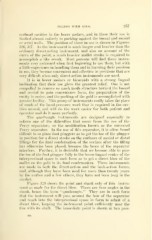Page 539 - My FlipBook
P. 539
FILLING WITH GOLD. 257
occlusal cavities in the lower molars, and in these their use is
limited almost entirely to packing against the buccal and mesial
or axial walls. The position of these in use is shown in Figures
32G, 327. As the instrument is much longer and heavier than the
ordinary direct-acting instrument, and also on account of the
curve of the point, a much heavier mallet stroke is reijuired to
accomplish a like result. Most persons will find these instru-
ments very awkward when first beginning to use them, but with
a little experience in handling them and in learning their position
in use, they become convenient and effective in positions that are
very difficult when only direct-action instruments are used.
It is in lower molars or bicuspids with a strong lingual
inclination that their use gives the greatest relief. One is not
compelled to remove so much tooth structure toward the buccal
and mesial to gain convenience form, the preparation of the
cavity is easier, and the packing of the gold is accomplished with
greater facility. This group of instruments really takes the place
of much of the hand-pressure work that is required in the cav-
ities named, and will do the work easier for both patient and
operator and do it more perfectly.
The quadrangle instruments are designed especially to
relieve one of the difficulties that occur from the use of the
Perry separator; or the modification known as the universal
Perry separator. In the use of this separator, it is often found
difficult to so place foot pluggers as to get the toe of the plugger
in position for a direct stroke on the surfaces of mesial or distal
fillings for the final condensation of the surface after the filling
has otherwise been placed, because the bows of the separator
interfere. Further, it is desirable that we become able to pass
the toe of the foot plugger fully to the bucco-lingual center of the
interproximal sjaace in such form as to get a direct blow of the
mallet on the gold in its final condensation. These instruments
are made in both the direct-action and the back-action forms,
and, although they have been used for more than twenty years
by the author and a few others, they have not been long in the
market.
Figure 329 shows the point and shank only of this instru-
ment as made for the direct blow. There are four angles in the
shank, hence the term "quadrangle." They are in such form
that the instrument will pass around the bow of the separator
and reach into the interproximal space in form to admit of a
direct blow, keeping the instrument point sufficiently near the
line with its shaft. The immediate point is shown in two posi-
36a


